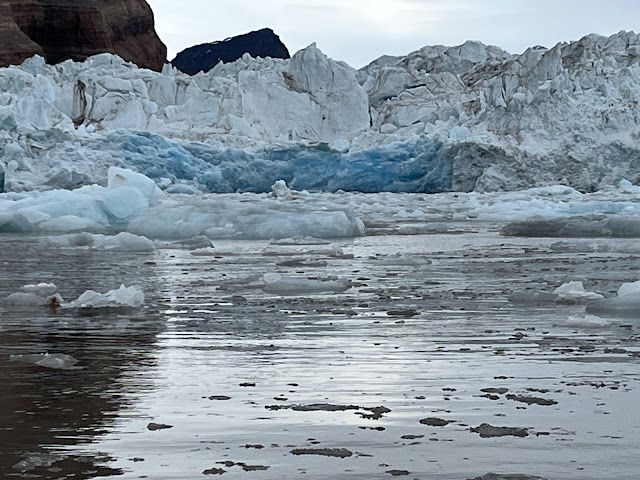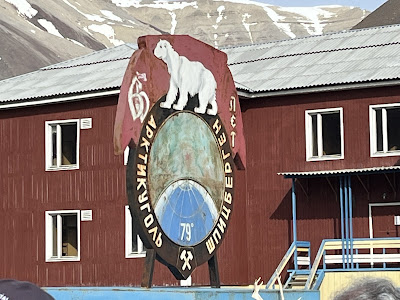This vacation was canceled for a year, twice, due to Covid. Exotic locales are sometimes difficult to get to. Our flight out was to Munich, to Copenhagen, to Oslo, and finally to Longyearbyen, capital of the Svalbard Archipelago. It has two thirds the land mass of Iceland, is located above the Arctic circle between Iceland and Norway and is part of Norway. The Germans named Svalbard Spitsbergen, “sharp mountains” as the scenery attests. The area was exploited by man, first for whales, then for walrus tusks, then for seal skins, then for the furs of land mammals and finally for coal until each was commercially extinct. Now it has come to depend on tourism.
 [Before Svalbard, an afternoon in Copenhagen which featured a thorough docent-led canal boat cruise through the harbor on a brilliant day. Better not stick your neck out going under the bridges, though.]
[Before Svalbard, an afternoon in Copenhagen which featured a thorough docent-led canal boat cruise through the harbor on a brilliant day. Better not stick your neck out going under the bridges, though.]More than half the passengers were French speaking and all announcements and most programs were presented in French first followed by English. The focus of the cruise was the excursions: to land or afloat in Zodiacs. The fleet of about ten such inflatables were lowered from the top deck to the water and raised up again, twice on most days.
One day, with no zodiac excursions, we sailed the ship to the polar ice cap and into the first hundred yards of the ice there. We were at 81° 16 minutes north latitude which I calculate was 601 miles from the north pole. Further north than I expect I will ever be again. Pictured is different Ponant ship, in the ice, taken from Le Boreal. From here on north the ice gets solid.
The most magnificent animals were the polar bears. Svalbard has more of them than it’s human population and the males amongst them (and the mothers when threatened) are the most dangerous animals around. That’s why whenever we went ashore our naturalists had high powered rifles to kill them with if they threatened us. I believe this signifies “Welcome to Svalbard; beware of polar bears,”
The naturalists knew where the bears had been the week before and look for them from the bridge of the ship with very high powered binoculars. From the zodiacs, at about 300 yards, the mother and two cubs looked rather like yellow smudges in the white snow. My cell phone, fully zoomed, captured them, but not well. With ILENE’s binoculars, which we took along, after 22 years of sea service since our wedding (thanks Jim) this scene of domestic tranquility, was clearly visible. But the best pictures were taken by professional photographers with long telephoto lenses. (Thanks Jan!)
The bears were staying where they were because mama had killed a walrus; it’s carcass kept wedged among some nearby rocks, the meat kept fresh by natural refrigeration.
We made several stops for different herds of walrus. They lie about on beaches, snuggled together for warmth, but these two were out playing.
We saw reindeer, though they were not pretty, with their winter coats half shed off.
And antlers when we walked on a section of tundra, only its top inch unfrozen in the 24 hours of sunlight in this era of global warming.
Birds, Kittiwakes and Gulls, nested en masse in wee clefts high on cliff faces
except when they come down to take a swim from an ice raft.A hike to the top of a ridge separating two huge bays gives a sense of the scope of things, with Le Ponant below.
These pretty purple flowers, Saxifrage, were everywhere, never growing more than a few inches high, and fauna grew higher.
The cruse ship fitted us with boots, life preservers and gave us, as souvenirs, the bright red foulie tops that we wore with waterproof trousers we had brought from home.

The ketch in this picture (maybe 50 feet long and hauling tourists, went further into the protected but shallow bay of the former whaling station. The navigation team held Le Ponant in place with her props and thruster for several hours while we explored the shore, it being too deep outside to anchor.
We stored our boots, preservers and hiking poles on mats outside each cabin.
A nice feature of this ship, not allowed, or only by special permission, on some other cruise ships, was that the bridge was open for passenger observation whenever the sun was shining, which was 24/7.
At one anchorage we checked out this wooden wreck, about 45 feet long.
An interesting stop was at a former Russian coal mining ghost town, Pyramiden, once home to 700 men, 300 women and 100 kids, with its communal mess hall, gym, swimming pool and concert hall with bust of Lenin. It is now maintained, somewhat, by a force of ten caretakers after mining operations stopped several decades ago.
One relatively warm afternoon the air temperature got to 50 degrees and the ship pumped its pool full of clean salty Arctic ice water. I got a chance to swim in a wee part of an ocean I’ve never swam in before, for a brief few seconds. The rest of the swim team, professors at UP, may come sailing on ILENE this summer after a session of their work at the UN on climate change.
A happy camper:
All told a very interesting adventure and it’s good to be back home, even with a touch of Covid.



























Wonderful description of your trip. It looked very exciting. Enjoyed reading it.
ReplyDeleteThank you for sharing your adventure! David
ReplyDeleteWell done and fascinating… Ken
ReplyDelete